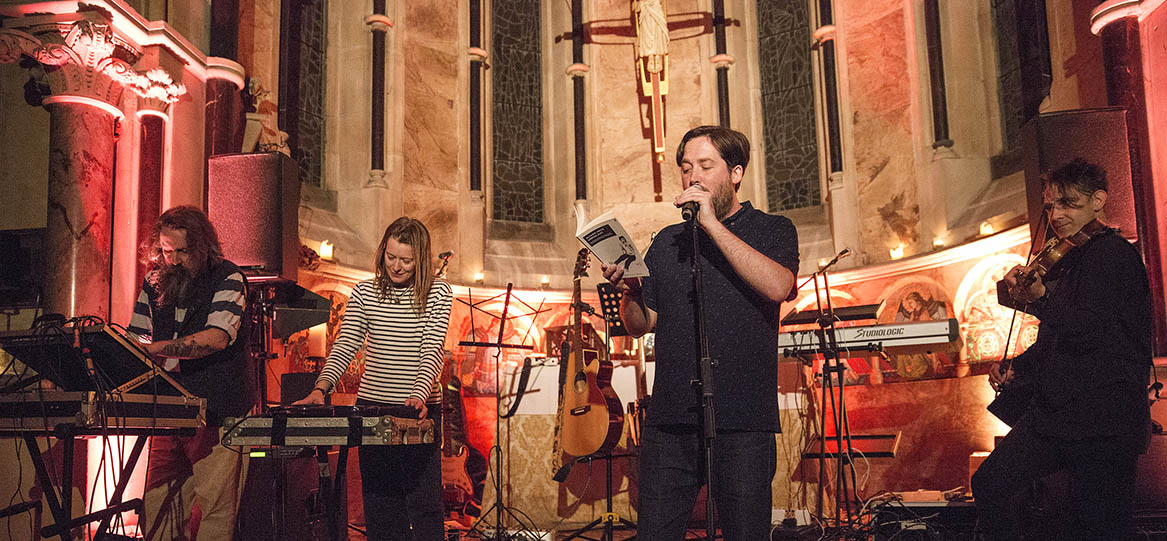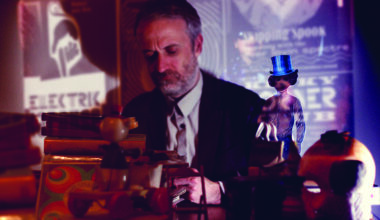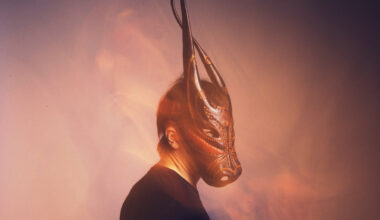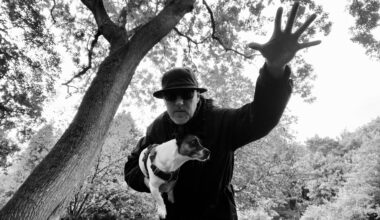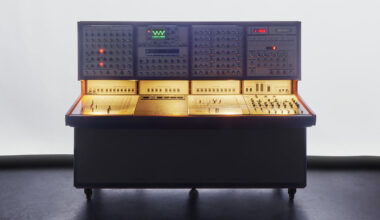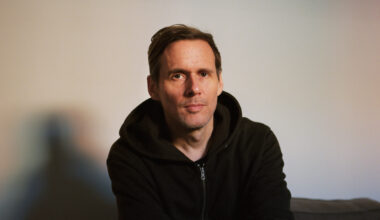Bocca Juniors vocalist Anna Haigh, Jagz Kooner from The Sabres Of Paradise, and acclaimed Faber author Michael Smith share their memories of working with Andrew Weatherall
Alongside the seemingly endless onslaught of incredible remixes, the classy production jobs and the life-affirming DJ sets, Andrew Weatherall was a serial collaborator. His longest musical partnership was with Nina Walsh – Lady Sabrette to his Lord Sabre – but she was far from alone in having him ride shotgun.
Right from the very beginning, he was involved in a raft of projects where he was quite happy to be part of a bigger picture. Nowhere more so than at the Boy’s Own fanzine. While it had been up and running since 1986 and was doing nicely, its popularity rocketed in the wake of the acid house revolution. A deal with London Records’ dancefloor offshoot FFRR saw the Boy’s Own crowd set up a label, on which it was suggested perhaps they’d like to release their own tunes. Billed as a Balearic supergroup and consisting of Andrew Weatherall, Terry Farley, Pete Heller and engineer Hugo Nicolson, Bocca Juniors were born.
The Weatherall tangled web machine was in full swing for Bocca Juniors’ two singles, ‘Raise (63 Steps To Heaven)’ and ‘Substance’. The collision of Boy’s Own and Shoom proved crucial. It was at the pioneering acid club that Weatherall had met not only Nina Walsh but also Anna Haigh, who supplied the vocals to both Bocca records. Haigh later cemented her status as a rave legend when she joined Flowered Up and took on the role of The E Queen in their memorable ‘Weekender’ video.
Anyway, Walsh and Haigh weren’t just passing acquaintances. They went way back.
“I was eight years old,” remembers Haigh. “We’d just moved to the area and I was the new girl in the school.
That’s when I met Nina, who was a misfit like me. We hit it off straight away.”
High jinks ensued from the off. Does Haigh have any stories she’d like to share? She does.
“We’d be running wild in the streets playing knock down ginger, trying to do roadside rope tricks for unwitting drivers, testing if we were psychic via unsuspecting teachers, letting off stink bombs in classrooms, playing green potato dare games, walking about in giant chicken suits…”
When they started exploring London’s nightlife, Walsh ended up at Shoom with her older brother. She had so much fun, she was desperate for her best friend to go with her next time.
“I think we were about 17,” says Haigh. “I’d only ever been to a couple of nightclubs before and they were more like cattle markets playing cheesy chart stuff. Shoom was different. It was like entering this world where you could lose yourself in the music. It sort of became part of you.”
The two girls first collided with Weatherall on one of those early visits to Shoom.
“He walked past wearing a long, rubbery, false nose, like the droogs wear in ‘A Clockwork Orange’,” grins Haigh. “I wasn’t sure if I’d seen it correctly, but there was a cheeky glint in his eye when he saw my jaw drop.”
One thing led to another and Weatherall and Walsh were soon a couple. The gang was starting to come together. When Bocca Juniors were looking for a singer, it was Walsh who suggested her pal. And Haigh was already well prepared for the job.
“I’d played guitar at school and an older boy asked me if I’d join his punk band,” she says. “It was in that band that I started singing too.”
FFRR threw a pile of cash at Bocca Juniors to record ‘Raise’, their 1990 debut single, putting them into a swish Maida Vale studio.
“I can’t recall the name of it, but it was very posh,” notes Haigh. “I’d only ever recorded in people’s living rooms before. I was pretty nervous, but there was a real buzz… plus I might have had a couple of shots!”
The second Boccas single, ‘Substance’, was a wholly different affair. Musically it was less Balearic, more the sound of Weatherall moving away from house music to do his own thing.
“Andrew wanted me to get more involved, so I wrote a tune on my acoustic and came up with some lyrics,” says Haigh. “Andrew added to the words and Pete Heller put in that killer guitar line. The whole gang did their magic on it.”
And then, after just two singles, Bocca Juniors were over.
“I was recording and touring with Flowered Up by that stage, as well as trying to do a degree in architecture, so I was happy,” asserts Haigh. “Plus the boys all went on to do great things individually, so no one was losing out. It was the first time I had worked on something of that magnitude and it was a good learning experience. Looking back now, I’m very sad that I didn’t do more work with Andrew, but ‘Raise’ is still a killer tune.”
Jagz Kooner wasn’t a complete rookie when he first met Weatherall. He already had his own little studio, where he was putting together songs with Dean Thatcher, a partnership that evolved into The Aloof.
“I was working with some great acts, including Jesus Jones and the DMC world champion DJ Chad Jackson,” explains Kooner. “I was also making bootlegs with Marino Cicero, an amazing keyboard player and a studio wizard.”
Word reached Kooner that Weatherall had played one of his bootlegs at a Boy’s Own weekender and it had sent the crowd wild. Like all good up-and-coming producers, Kooner was out most nights of the week himself, keeping his finger on the musical pulse at a range of London clubs. His regular haunts included Flying at the Soho Theatre Club, which was tucked away behind The Astoria.
“I used to go to Flying because Dean Thatcher was the resident DJ there and they always had lots of guests too,” says Kooner. “I was there one night with Gary Burns, who was also in The Aloof, and Andrew was there as well. He walked over and said he loved the music I was making… which was a bit of a surreal moment.”
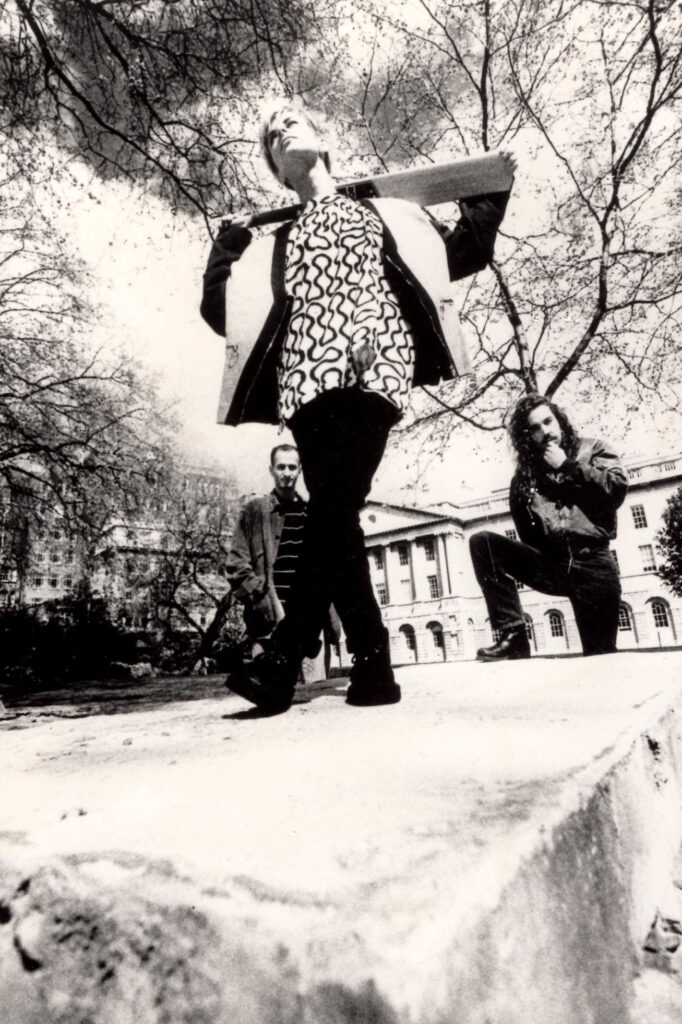
Weatherall was the most talked-about DJ and remixer at that time. The music he was playing and making was really pushing the boundaries, so such compliments were high praise.
“He suggested we should get into the studio together,” continues Kooner. “It was one of those late-night conversations you generally can’t remember the following day.”
Weatherall was quite serious and called Kooner up a little later, inviting him and Gary Burns to collaborate on an overhaul of ‘Visions Of You’ by Jah Wobble’s Invaders Of The Heart, featuring Sinéad O’Connor on vocals.
“It was the first time that I had been in a big posh studio,” recalls Kooner. “Andrew was brilliant to be around and he loved all the ideas that Gary and I added to the remix. It was a very successful session.”
With more remix work rolling their way, Weatherall suggested the three of them should record some original material together. They took the name The Sabres Of Paradise from the title of the B-side of Haysi Fantayzee’s early 80s hit ‘John Wayne Is Big Leggy’, which itself came from the title of a 1960 book about Cossacks, and set up shop at Sabresonic Studios. Weatherall bigged up the place on his Kiss radio shows, talking about how he’d be walking around the long corridors. In truth, it was in a room above a shop on the Beavers Estate in Hounslow, west London.
“It was a great place, though,” says Kooner. “It was kitted out with some superb equipment. Nina Walsh was in the same building, running the Sabres label with Andrew, and Chris Butler had his Whitenoise promotions company there, working with people like Massive Attack and Carl Craig. It was a really vibey place. We were a very creative unit, sometimes writing three or four tracks a week.”
Or, according to the story, two in one afternoon. ‘Theme’ and ‘Wilmot’, wasn’t it?
“That’s correct,” confirms Kooner. “With most of our songs, we’d usually put the original idea down in a few hours and then flesh it out over the course of a day.”
And let’s not forget they were responsible for the showstopping classic ‘Smokebelch II’.
“When we were working on a song, we would never view it as anything special, it was just something else that needed finishing,” says Kooner. “But afterwards, in the cold light of day, I think we were pleasantly surprised by how well that one turned out.”
After a couple of releases on the Sabres imprint, there was a major label bunfight to sign the trio. They were one of four acts being tipped for very big things at that point. The other three were Underworld, The Prodigy and The Chemical Brothers.
“I was never really concerned about the bidding war that was going on,” notes Kooner. “We were massive fans of Warp and we weren’t particularly interested in signing with anyone else. We felt they were the only label that would give us the creative freedom to do whatever we wanted.”
The Sabres Of Paradise released three albums on Warp between 1993 and 1995, but like Bocca Juniors they fizzled out far too soon.
“It was a great team of people involved and I’m super-proud of everybody, but the demise of Sabres is something that still troubles me,” admits Kooner. “I think we could have done a lot more. We were only just getting started. But I suppose things sometimes run their course and maybe that makes the myth of The Sabres Of Paradise far bigger than the reality might have ever been.”
In 2013, Weatherall entered into a curveball collaboration when he was named as the inaugural artist-in-residence for Faber Social, an imprint specialising in music books. You’d kind of expect a publishing house to give that role to a writer, but this was no ordinary appointment.
“He had an incredible mind,” says Michael Smith, who was the first Faber Social author to work with Weatherall. “Beyond music, he was endlessly curious. He was a real Renaissance man, the sharpest pin in the box. He was more erudite than most of the literary types you get hanging round Faber & Faber.”
The plot thickens when you learn that Smith first met Weatherall at an arts festival.
“It was the Port Eliot Festival in Cornwall,” he explains. “It’s this fairytale setting in the grounds of an old aristocratic pile with a gilded collection of artistes and punters. I was off my nut and a man with an enormous Victorian cricketer’s beard came over and shook my hand. His arm was covered in tattoos. I thought, ‘Fuck, it’s Alan Moore!’. He said, ‘Mr Smith… I’m a fan of your work… Andrew Weatherall’. I thought, ‘Fuck, it’s Andrew Weatherall! Even better!’.”
Where do you go with that kind of thing? Smith had spent his formative years with ‘Screamadelica’ ringing in his ears. To discover the man whose vision that was happened to be a fan of your work…
“I was really flattered,” says Smith. “It transpired we were into a lot of the same things – esoteric ideas and less trodden paths. He had a mind full of such strange and interesting stuff. I found him totally inspiring.”
At the time, Faber Social were gearing up for the publication of ‘Unreal City’, Smith’s third novel.
“I had a meeting with my editor Lee Brackstone and he suggested I did a musical collaboration for the book, as I’d done with my first novel, ‘The Giro Playboy’,” says Smith. “I was like, ‘That’s a great idea… you’ll never guess who I met last week in Cornwall’.”
As Smith eloquently puts it, “shy lads get nowt”, so they asked a mutual friend, Heavenly boss Jeff Barrett, to test the water. They were thrilled when Weatherall was up for it. And even more thrilled when he brought an album’s worth of original material to ‘Unreal City’. It was essentially a soundtrack to the book.
“I couldn’t believe it,” chuckles Smith. “I remember going to the studio to hear the tracks for the first time.
We were both a bit nervous, in case I didn’t like them, but I was overjoyed.”
‘Unreal City’ was published in September 2013 and the music was released as a limited edition six-track CD and one-sided 10-inch featuring a Weatherall remix of ‘The Deep Hum (At The Heart Of It All)’. The tracks were also played live at various readings.
“We had Nina Walsh and Franck Alba on guitars, violins and more, Andrew doing ‘whizz-bangs’ on a mixing desk with this bizarre device I didn’t really understand, and me reading from the book over the top,” says Smith. “It was a breath of fresh air compared to all those boring book readings. Who gets to promote their new book with Andrew Weatherall making weird noises in the background? It felt like a massive privilege.”
Weatherall and Walsh subsequently composed the scores for ‘Stranger On The Shore’, a trilogy of short films Smith made with Maxy Bianco about the peculiarities of places on the English coast.
“The music fits so beautifully,” smiles Smith. “We did a few gigs for those too, culminating in a show at the National Film Theatre, which was pretty special. Andrew sang a song after I’d done my reading.”
Weatherall was hugely proud of being Faber Social’s artist-in-residence, but he could never quite pin down precisely what his role entailed.
“I think that’s why he was so good at it,” says Smith. “His modus operandi was to not limit things with a definition, but to let the work decide where it wanted to go. He was very into that idea. I used to watch him in the studio with Nina and it was always unplanned and unfettered. They’d spend a lot of time chatting and joking, then noodling about, exploring a musical idea, and suddenly it would gel into something concrete. He was the freest artistic spirit I ever met and that had a lot to do with his refusal to define his role.”
With most of his other collaborations, Weatherall’s restlessness, his need to continually move on, saw the projects come to an end ahead of their time. And in a way, in the very worst way, the same thing happened to his work with Michael Smith.
“The last time that I ever saw him, he DJed at my missus’ pub, The Marina Fountain in St Leonards,” says Smith. “This wasn’t too long before he passed away. My cousin Darren was there and he was telling me how he believed Andrew had this uncanny instinct to hone in on whatever the frequency is that brings about a raising of human consciousness, like going to an evangelical church or in the way a voodoo ceremony might work. I remember thinking Andrew did seem to be plugged into some higher energy that night and was channelling it for us. It’s a nice last memory to have of him.”
